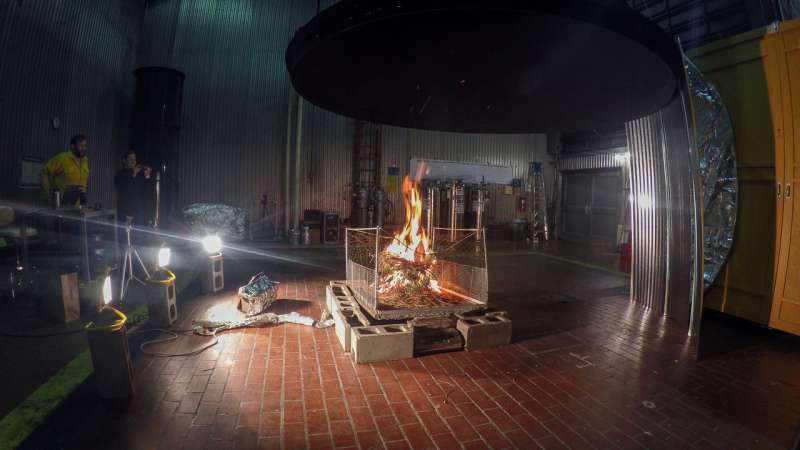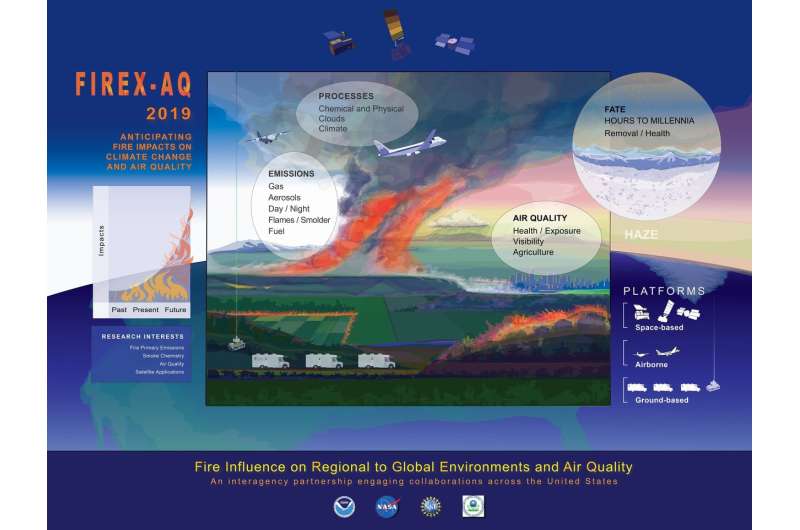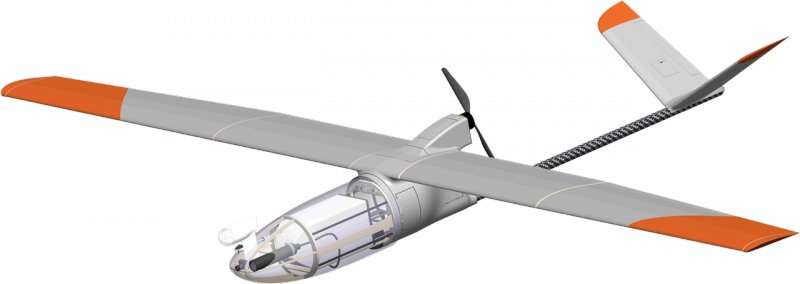Wildfire temperatures key to better understanding air quality

When wildfires burn, they don't only damage land, homes, and businesses. Wildfire emissions, which can be transported over long distances, can be toxic and contribute to the formation of secondary pollutants such as ozone and fine particles in the atmosphere. Those emissions affect human health and the environment, so scientists want to know what's in wildfire smoke. According to new research from CIRES and NOAA, what matters most is not what kind of fuel is burning, but the temperature at which it burns.
"If we know the temperature of a fire, we can better estimate what comes out of it, independent of what's burning," said Carsten Warneke, a CIRES researcher at the University of Colorado Boulder working in the NOAA Earth System Research Laboratory and a co-author on the paper, published July 3 in the journal Atmospheric Chemistry and Physics. "With that information, we'll be able to simplify the emissions models, better predict the downwind impacts of wildfires, and get much better forecasts for air quality."
It looks like lower-temperature fires actually produce more tiny particles called aerosols, which can get into people's lungs and mix in the atmosphere to form haze and other air pollutants downstream.
The U.S. West faces a future with more frequent and intense wildfires, according to climate projections and in part because of policies that have long encouraged fire suppression. Against that backdrop, scientists from CIRES and NOAA are teaming up with scientists from NASA to lead a multi-year field campaign called NOAA-NASA FIREX-AQ—Fire Influence on Regional to Global Environments Experiment–and Air Quality—to better understand the air quality and climate effects of wildfires. The new paper came out of an early FIREX investigation in 2016 in the Missoula, Montana-based Fire Lab, run by the U.S. Forest Service.

Fires produce complex emissions, releasing thousands of different volatile organic compounds (VOCs) that are often difficult to measure. Scientists initially thought wildfire emissions are mostly dependent on the type of fuel burned—for example, Douglas fir, Ponderosa pine, or sage brush. The goal of the Fire Lab study was to better understand emissions of vegetation burning in a simple and controlled environment. To do that, a team of CIRES and NOAA scientists burned over 100 fires made from various fuels found in the western United States and sampled the emissions continuously with state-of-the art instruments.
The new research suggests understanding these emission patterns may be much simpler than researchers previously believed: it's the temperature of the burn and not what's burning, that's key to understanding fire emissions. Researchers could explain around 85 percent of the variability of the VOC emissions once they knew how hot a fire was: some VOCs were emitted primarily from high-temperature burns, while others were emitted from low-temperature burns. Over its course, a single fire burns at both higher and lower temperatures, releasing different VOCs at various stages. Those compounds released from low temperature burns have properties that make them more likely to form aerosols in the fire plumes.
"These results completely change the way we understand VOC emissions from wildfires," said James Roberts, a NOAA scientist and FIREX-AQ principal investigator. "Instead of looking at the type of fuel burned, we can focus on the temperature of the burn, something that can potentially be measured from satellites."
Those initial results from Fire Lab will help the CIRES and NOAA researchers and their colleagues during the FIREX field campaign, slated for the 2019 fire season. The team will study the impact of western U.S. wildfires on the atmosphere and climate with the goal of developing policy-relevant information and tools to help manage fires.

As part of a newly-announced partnership, the NASA DC-8 aircraft will carry a payload of NOAA instruments, among others, on wide-ranging flights targeting western U.S. wildfires and also agricultural and prescribed burns across the southeast United States. One NOAA Twin Otter aircraft will fly over western wildfires and prescribed fires at night, sampling emissions along the way. Another NOAA Twin Otter will measure windfields feeding the fires. Mobile labs and stationary instruments will collect emission samples on the ground, and researchers will also use satellite data to help pinpoint fire temperature and track emissions on regional to global scales. And a CIRES and NOAA team will deploy an instrumented unmanned aircraft system, or UAS, over some wildfires at night. See "Sending a UAS Above The Flames" below.
"Wildfires are one of the larger remaining issues for air quality in the United States," said Roberts. Their FIREX study could provide answers to many outstanding questions. "By doing our homework in the lab, we have identified what's in emissions and the actual process of how emissions are made," said Warneke. "Now we need to go into the field to understand real fires."
Sending a UAS Above The Flames
Wildfires burn differently at night because meteorological conditions—including temperature, energy from sunlight, humidity, and winds—aren't the same as during the day. Health effects downwind from wildfires can be more severe at night, because those conditions can trap smoke closer to the ground, concentrating emissions. High-resolution nighttime observations of a fire's size, location, and heat output can provide key inputs to fire weather models to improve fire weather forecasts.
While manned research and firefighting aircraft don't usually fly near wildfires at night for safety reasons, unmanned aircraft systems (UAS) are well-suited for the job. For that reason, NOAA's Nighttime Fire Observations eXperiment (NightFOX) is slated to take part in the FIREX-AQ field campaign. Working with CU Boulder's department of Aerospace Engineering Sciences and the NOAA UAS Program Office, NOAA and CIRES researchers at the NOAA Earth System Research Laboratory will send an instrument-equipped small UAS to make nighttime wildfire measurements. In addition to monitoring a fire's temperature and extent using multi-spectral remote sensing instruments, NightFOX will measure carbon monoxide and carbon dioxide to determine how the fire is burning and aerosols in the fire plume to characterize emissions that lead to local and regional health impacts.
More information: Kanako Sekimoto et al. High- and low-temperature pyrolysis profiles describe volatile organic compound emissions from western US wildfire fuels, Atmospheric Chemistry and Physics (2018). DOI: 10.5194/acp-18-9263-2018
Journal information: Atmospheric Chemistry and Physics
Provided by University of Colorado at Boulder


















